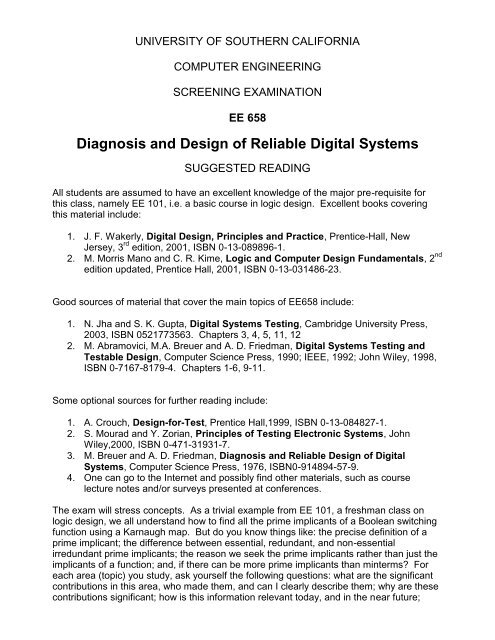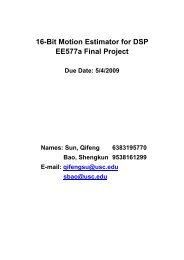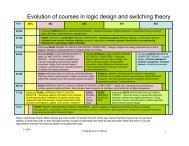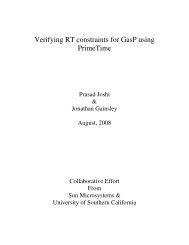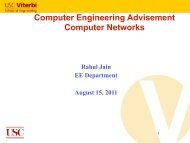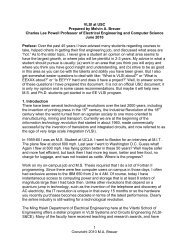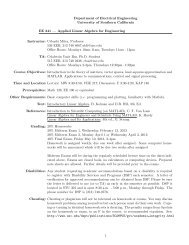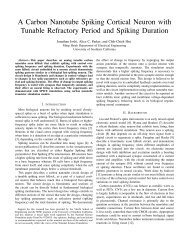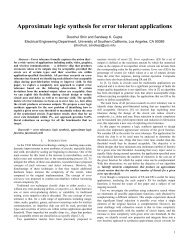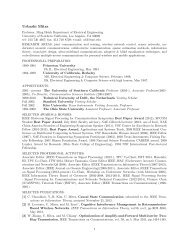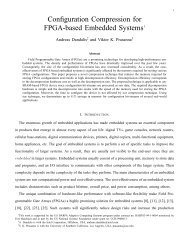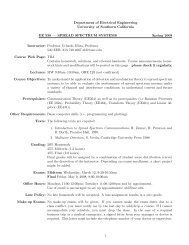EE 658 - University of Southern California
EE 658 - University of Southern California
EE 658 - University of Southern California
Create successful ePaper yourself
Turn your PDF publications into a flip-book with our unique Google optimized e-Paper software.
UNIVERSITY OF SOUTHERN CALIFORNIA<br />
COMPUTER ENGIN<strong>EE</strong>RING<br />
SCR<strong>EE</strong>NING EXAMINATION<br />
<strong>EE</strong> <strong>658</strong><br />
Diagnosis and Design <strong>of</strong> Reliable Digital Systems<br />
SUGGESTED READING<br />
All students are assumed to have an excellent knowledge <strong>of</strong> the major pre-requisite for<br />
this class, namely <strong>EE</strong> 101, i.e. a basic course in logic design. Excellent books covering<br />
this material include:<br />
1. J. F. Wakerly, Digital Design, Principles and Practice, Prentice-Hall, New<br />
Jersey, 3 rd edition, 2001, ISBN 0-13-089896-1.<br />
2. M. Morris Mano and C. R. Kime, Logic and Computer Design Fundamentals, 2 nd<br />
edition updated, Prentice Hall, 2001, ISBN 0-13-031486-23.<br />
Good sources <strong>of</strong> material that cover the main topics <strong>of</strong> <strong>EE</strong><strong>658</strong> include:<br />
1. N. Jha and S. K. Gupta, Digital Systems Testing, Cambridge <strong>University</strong> Press,<br />
2003, ISBN 0521773563. Chapters 3, 4, 5, 11, 12<br />
2. M. Abramovici, M.A. Breuer and A. D. Friedman, Digital Systems Testing and<br />
Testable Design, Computer Science Press, 1990; I<strong>EE</strong>E, 1992; John Wiley, 1998,<br />
ISBN 0-7167-8179-4. Chapters 1-6, 9-11.<br />
Some optional sources for further reading include:<br />
1. A. Crouch, Design-for-Test, Prentice Hall,1999, ISBN 0-13-084827-1.<br />
2. S. Mourad and Y. Zorian, Principles <strong>of</strong> Testing Electronic Systems, John<br />
Wiley,2000, ISBN 0-471-31931-7.<br />
3. M. Breuer and A. D. Friedman, Diagnosis and Reliable Design <strong>of</strong> Digital<br />
Systems, Computer Science Press, 1976, ISBN0-914894-57-9.<br />
4. One can go to the Internet and possibly find other materials, such as course<br />
lecture notes and/or surveys presented at conferences.<br />
The exam will stress concepts. As a trivial example from <strong>EE</strong> 101, a freshman class on<br />
logic design, we all understand how to find all the prime implicants <strong>of</strong> a Boolean switching<br />
function using a Karnaugh map. But do you know things like: the precise definition <strong>of</strong> a<br />
prime implicant; the difference between essential, redundant, and non-essential<br />
irredundant prime implicants; the reason we seek the prime implicants rather than just the<br />
implicants <strong>of</strong> a function; and, if there can be more prime implicants than minterms? For<br />
each area (topic) you study, ask yourself the following questions: what are the significant<br />
contributions in this area, who made them, and can I clearly describe them; why are these<br />
contributions significant; how is this information relevant today, and in the near future;
what are the associated counting/enumeration/complexity issues associated with any<br />
important algorithmic techniques in this field.<br />
****************<br />
Please be aware that these references are for guidance in BASIC<br />
knowledge. Ph.D. candidates are screened on the basis <strong>of</strong> talent, course<br />
knowledge, independent reading and experience.<br />
****************


